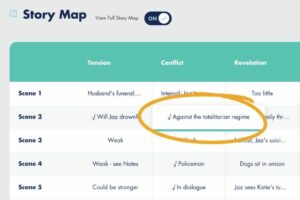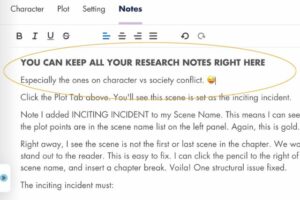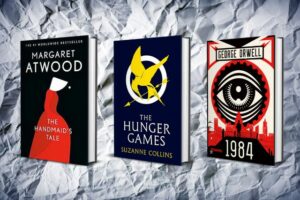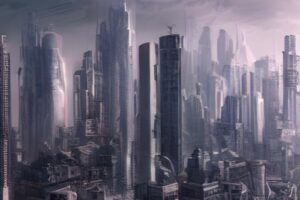Conflict is the story element that drives your novel forward. If you don’t have tons of conflict between your pages… then your readers will find another book to read. There are 5 major types of conflict in fiction you need to know about, my writerly friend. And one of those conflict types is character vs society conflict.
This type of conflict is so popular because most of us have experience of societal conflict, and if we’ve never experienced it before, we only have to turn on the news to understand how it works.
And that’s great… but how does this type of conflict work, and how can you use it to engage readers?
Excellent question.
I used to find writing conflict super challenging. Did I have enough conflict in my stories? Was that conflict strong enough? Had I done it right? I spent ages pouring over my early manuscripts deciding whether the conflict there was good enough…
Until I found the Fictionary Software. One of the 38 Story Elements Fictionary teaches you to use is conflict and, using the Story Map Visual Insight, you can easily track your use of Conflict throughout your novel.
Talk about a game-changer.
And character vs society conflict is no different. You can track that too.
So, let’s delves in to what this kind of conflict is, and how you can use it to keep your readers glued to your novels.
What is Character vs Society Conflict (AKA Man vs Society or Person vs Society Conflict)?
Ask yourself: Do I understand what character vs Society conflict is?
Conflict can only happen if your protagonist or point of view character experiences opposition. Character vs society conflict happens when your protagonist (main character) is fighting tooth-and-nail against an unfair and/unjust society. In these types of stories, the antagonist (villain) is not a person. Society itself becomes the antagonist.
In other words, the unfair rules of your society are placing obstacles in the way of your protagonist (and likely your major side characters) getting what they want.
We’ll go into specific examples from fiction later, but character vs society conflicts often see your characters battling:
- Corrupt governments
- Tyrannical royal families
- Unjust class system
- Inequality within society
- And more…
NOTE: You might see people refer to character vs society conflict as man vs society conflict. In this context, it doesn’t relate to male characters, but to humanity. People also refer to it as person vs. society conflict. I’ll be using all three terms throughout this article.
Action: Every time you use this type of conflict in your story, make a note of the societal issue that’s causing the conflict, and whether you think the conflict is strong enough. If you’re using the Fictionary Software, it’s easy to track your conflict usage using the Story Map Visual Insight. You’ll be able to see the conflict you’ve used in every scene at a glance, and work out whether it best serves your story.

Why Person vs Society is a Fantastic Type of External Conflict
Ask yourself: Do I understand why character vs society conflict is so powerful?
Remember, external conflict (conflict that happens outside a character) is when an antagonist—or antagonistic force—places obstacles in the way of your characters achieving their goals. In other words, the antagonist or antagonistic force causes problems for your protagonist and major side characters.
Now, think about society, and all the problems it can cause in our everyday lives.
How unfair is it when you witness the elderly treated worse than the young, because of ageism? How annoyed do you get when you experience injustice because of someone’s race/gender/sexuality/socio-economic status? And isn’t it anger-making when (on a global level) you hear about corrupt governments hording food/resources/money that could help their nation’s citizens.
In each of these scenarios, societal issues cause problems that make it harder for people to achieve their external goals.
And that’s part of the reason character vs society conflict is so powerful.
It’s something many people are familiar with.
People know what it’s like to go head-to-head with society and lose. Your readers know how this feels too, so they’ll sympathise with your characters when man vs society conflict stops them from getting what they want.
Action: Learn as much as you can about character vs society conflict before you write your story, and keep notes on the discoveries you make. If you’re using the Fictionary Software, you can use the Notes panel next to each scene to keep all your research notes in one place and reference them easily.

Examples of Man vs Society Conflict in Fiction
The best way to learn about a conflict type is to analyse examples from fiction and see how other authors do it. Luckily, there are plenty of character vs society conflict novels we can use for this exact purpose.
Let’s look at three popular examples of person vs nature conflict in fiction.
The Handmaid’s Tale by Margaret Attwood
In The Handmaid’s Tale by Margaret Attwood, the protagonist, Offred, faces many forms of societal conflict. Three include:
- Loss of Personal Identity: Society doesn’t allow Offred her own name, because women “belong” to men. Offred “belongs” to a man named Fred, so her name literally means “Of Fred”.
- Enforced Reproduction: Handmaids have no free choice when it comes to having children. Their major function in society is to reproduce, and refusal isn’t an option.
- Loss of Freedom and Autonomy: Attwood’s society denies woman basic freedoms many of us enjoy (i.e., society has forbidden reading, writing, of free movement if you are a woman).
The Hunger Games by Suzanne Collins
In The Hunger Games by Suzanne Collins, the protagonist, Katniss Everdeen, faces many forms of societal conflict. Three include:
- The Games Themselves: The Hunger Games, where teenagers battle to the death to bring riches to their impoverished districts, are society’s way of controlling the districts.
- Economic Inequality: The districts are poor and many live in poverty. The Capitol (the capital city of Panem) is rich beyond most people’s wildest dreams.
- Autocratic Control: The Capitol exerts strict control over the districts, turning traitors into “Avoxes” by cutting their tongues out so they can’t speak.
1984 by George Orwell
In 1984 by George Orwell, the protagonist, Winston Smith, faces many forms of societal conflict. Three include:
- Thought Control: Orwell introduces the concept of “thought-crime”, and having thoughts that don’t align with society carries a death sentence.
- Constant Surveillance: The telescreens constantly watch everyone, as do friends and neighbours, who might report you for doing something “wrong”.
- Inaccurate Propaganda: Winston’s job involves “correcting” history, so historical events allign with what Orwell’s society accepts.

Conclusion: Character vs Society Conflict
There you have it, folks.
Mastering the art of character vs. society conflict can transform your story into one readers will love. This type of conflict, when done well, creates stories that will have readers perched on edge of their seats, holding their breath in anticipation of what’s coming next.
It’s a potent weapon in your writerly toolbox, but like any tool, you’ve got to know how to weild it.
That’s where Fictionary Software comes in.
This nifty tool helps you map out your conflict, ensuring it’s a wild roller coaster ride that keeps readers glued to your pages. And the best part? You don’t have to take my word for it. You can try it out for yourself, absolutely free.
Take a 7-day free trial of Fictionary Software.



